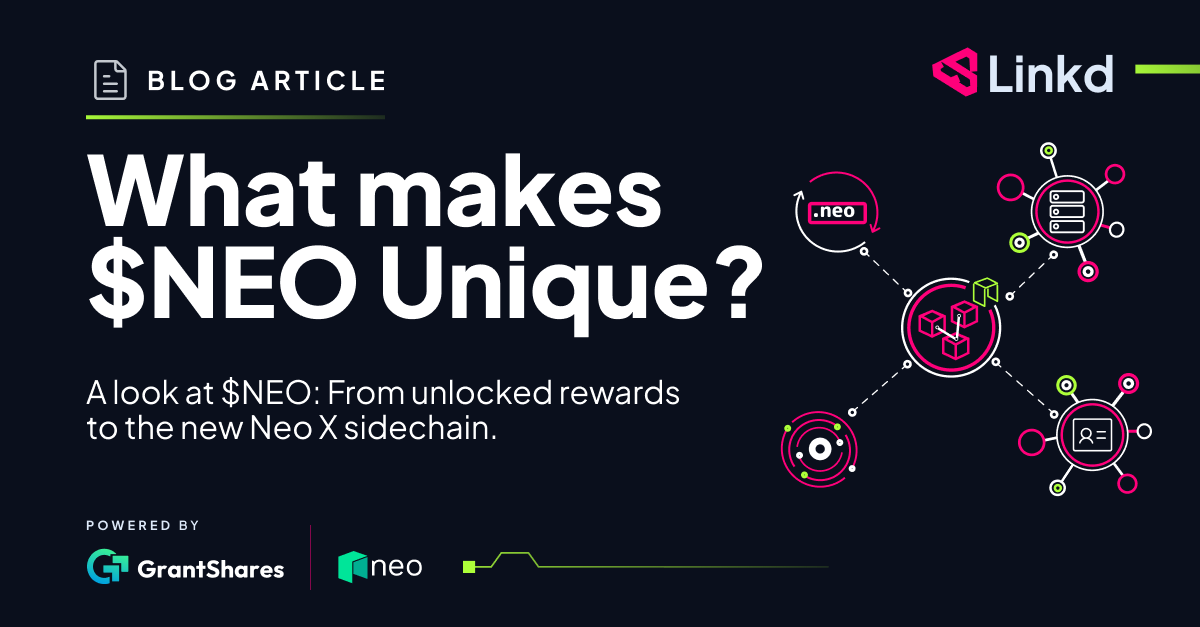What Makes Neo Blockchain Unique?
Neo Blockchain Overview

The Neo Blockchain was one of the first networks to allow the development of smart contracts. Launched in 2016 as Antshares and rebranded to Neo in 2017, the platform has significantly upgraded over the last few years. The most recent one was the Neo N3, while another one, the Neo X , is coming soon.
Despite losing its position in the top 10 coins, the network has successfully survived several bear markets. Even during the bear market, the team never stopped working on new features. The Neo blockchain has developed several technologies that make it unique compared to competing networks.
Unlocked Staked Rewards — Hold $NEO and earn $GAS
This is one of Neo’s best features. The platform uses a dual token model: $NEO and $GAS. Users may get up to 20% APY by voting with their Neo. There is no need to lock them or use third-party applications; it’s embedded in the network protocol.
Visit the GAS Calculator for more details
Smart Contracts using Python, Java, C# and Go
Unlike Ethereum, Neo decided to build its technology by targeting an existing developer audience. Instead of Solidity, the platform supports multiple programming languages, such as C#, Go, Python, and Java.
This made the platform much more user-friendly for new developers, allowing them to reuse their existing knowledge to build decentralized applications.
According to the TIOBE Index, Solidity is only used by 0.29% of the developers, while the programming languages supported by Neo are at 33%.
In summary, we can list several benefits from this approach:
Easier Onboarding: It’s easy for developers to start coding on Neo. This is because they can reuse their existing knowledge to build dApps.
Enterprise Technology Stack: Neo supports programming languages that are enterprises’ favorites. Most companies don’t build projects using different technologies.
More Developers: It’s much easier to find and hire developers who can code in Java, Python, C#, or Go, which allows companies to expand their teams.
Low Transaction Finalization Time
A blockchain transaction can only be considered finalized when it becomes impossible to reverse it. This process takes several minutes for many blockchains. Bitcoin transactions, for example, take up to 40 minutes to be considered irreversible, while on Neo, it only takes 15 seconds.
Single Block Finality
On many chains, multiple blocks are required to ensure that a transaction has been permanently confirmed. On Neo, this doesn’t happen. It only needs one confirmation to ensure it’s finalized and irreversible. This drastically improves security and overall experience. Exchanges can process deposits and withdrawals much faster since waiting for several blocks is unnecessary and risk-free.
Extended Blockchain Features
Besides the default functionalities found in other blockchains, Neo has developed other features that developers demand.
Decentralized Storage
Blockchains are not meant to store large documents. Usually, applications store only the URL in the ledger, putting the document elsewhere. Storing it on centralized solutions poses some risks. If the host is taken down, the files will be permanently lost. This happened in the past, causing people to lose their NFTs.
The Neo File System, Neo FS, is similar to IPFS, except it’s a native feature that uses GAS.
Internet Access using Oracles
Blockchain applications cannot access the Internet—at least not directly. Relying on centralized solutions to solve the internet access problem is unsafe.
The solution is to rely on external actors, the oracles, who bring information from the outside world into the blockchain.
Allowing developers to retrieve external information directly from the blockchain is a huge accomplishment that increases the number of use cases supported by the Neo network.
NNS — DNS for Neo Users
Using Names instead of addresses has many benefits. It’s easier for users to memorize names. Another advantage of NNS is that it burns all the fees used to manage the system. This removes $GAS from circulation, reducing inflation.
Voteable Fees
Control over transaction fees is essential. High fees may hinder adoption, scaring users and developers. However, with all the price volatility, it’s impossible to set the fees to one value and forget about them. The fees must be used to balance adoption and resource consumption. To address this problem, Neo allows committee nodes to update the fees.
Neo X — EVM Sidechain
Neo X is the next major upgrade coming to Neo. It’s a new network, a sidechain, that will be compatible with the Ethereum Virtual Machine.
Despite not being the only network with Ethereum virtual machine compatibility, the new side chain will be much more than just a side network using EVM.
The new chain is not just a copy-and-paste. It will inherit the Neo consensus algorithm, DBFT, with extra capabilities. One is protection against MEV bots, a billion-dollar problem affecting Ethereum and Solana.
Welcoming Existing Protocols and Developers
One downside of building its technology stack was that applications like DeFi protocols could not integrate with Neo. This won’t be something special.
The existing platform is suitable for attracting existing developers, even senior ones. However, many blockchain devs will use Solidity due to Ethereum and related networks. Just as existing developers don’t want to learn a new programming language, existing DeFi developers will likely prefer Solidity when building decentralized applications.
Most DeFi protocols already operate on multiple chains. The bottleneck has likely been compatibility. Neo X will likely overcome these problems.
What Makes Neo Unique
In general, Neo has demonstrated resilience and adaptability to challenges. This approach has made Neo a versatile and inclusive blockchain network with a growing community of developers and users.
Overall, the Neo blockchain’s unique features, including unlocked staked rewards, multi-language smart contract support, low transaction finalization time, extended blockchain features, and the upcoming Neo X sidechain, make it a competitive player in the blockchain space.
